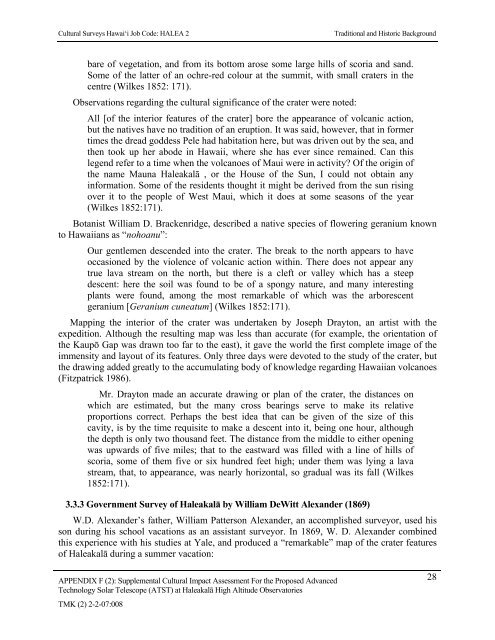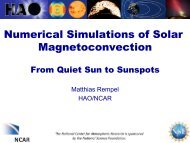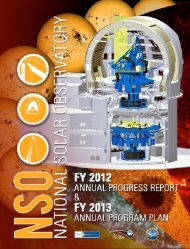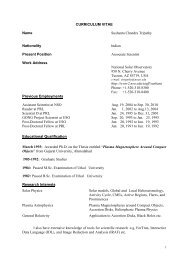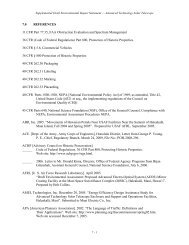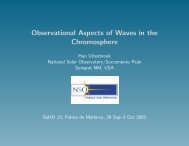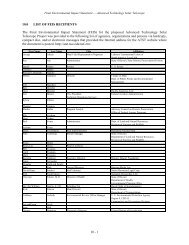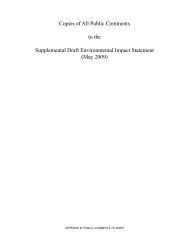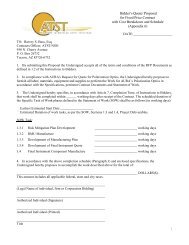F2 - ATST
F2 - ATST
F2 - ATST
Create successful ePaper yourself
Turn your PDF publications into a flip-book with our unique Google optimized e-Paper software.
Cultural Surveys Hawai‘i Job Code: HALEA 2Traditional and Historic Backgroundbare of vegetation, and from its bottom arose some large hills of scoria and sand.Some of the latter of an ochre-red colour at the summit, with small craters in thecentre (Wilkes 1852: 171).Observations regarding the cultural significance of the crater were noted:All [of the interior features of the crater] bore the appearance of volcanic action,but the natives have no tradition of an eruption. It was said, however, that in formertimes the dread goddess Pele had habitation here, but was driven out by the sea, andthen took up her abode in Hawaii, where she has ever since remained. Can thislegend refer to a time when the volcanoes of Maui were in activity? Of the origin ofthe name Mauna Haleakalā , or the House of the Sun, I could not obtain anyinformation. Some of the residents thought it might be derived from the sun risingover it to the people of West Maui, which it does at some seasons of the year(Wilkes 1852:171).Botanist William D. Brackenridge, described a native species of flowering geranium knownto Hawaiians as “nohoanu”:Our gentlemen descended into the crater. The break to the north appears to haveoccasioned by the violence of volcanic action within. There does not appear anytrue lava stream on the north, but there is a cleft or valley which has a steepdescent: here the soil was found to be of a spongy nature, and many interestingplants were found, among the most remarkable of which was the arborescentgeranium [Geranium cuneatum] (Wilkes 1852:171).Mapping the interior of the crater was undertaken by Joseph Drayton, an artist with theexpedition. Although the resulting map was less than accurate (for example, the orientation ofthe Kaupō Gap was drawn too far to the east), it gave the world the first complete image of theimmensity and layout of its features. Only three days were devoted to the study of the crater, butthe drawing added greatly to the accumulating body of knowledge regarding Hawaiian volcanoes(Fitzpatrick 1986).Mr. Drayton made an accurate drawing or plan of the crater, the distances onwhich are estimated, but the many cross bearings serve to make its relativeproportions correct. Perhaps the best idea that can be given of the size of thiscavity, is by the time requisite to make a descent into it, being one hour, althoughthe depth is only two thousand feet. The distance from the middle to either openingwas upwards of five miles; that to the eastward was filled with a line of hills ofscoria, some of them five or six hundred feet high; under them was lying a lavastream, that, to appearance, was nearly horizontal, so gradual was its fall (Wilkes1852:171).3.3.3 Government Survey of Haleakalā by William DeWitt Alexander (1869)W.D. Alexander’s father, William Patterson Alexander, an accomplished surveyor, used hisson during his school vacations as an assistant surveyor. In 1869, W. D. Alexander combinedthis experience with his studies at Yale, and produced a “remarkable” map of the crater featuresof Haleakalā during a summer vacation:APPENDIX F (2): Supplemental Cultural Impact Assessment For the Proposed Advanced 28Technology Solar Telescope (<strong>ATST</strong>) at Haleakalā High Altitude ObservatoriesTMK (2) 2-2-07:008


